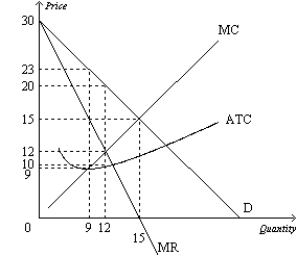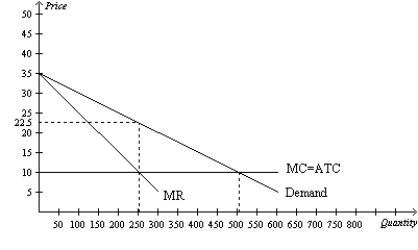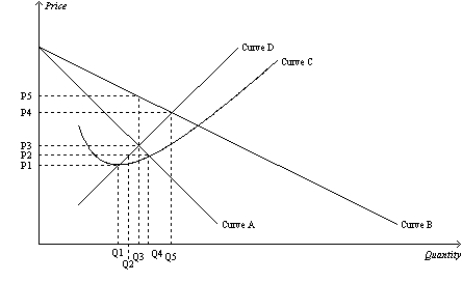A) produces that output where average total cost is at a maximum.
B) is protected by barriers to entry.
C) operates as a price taker rather than a price maker.
D) earns revenues that exceed variable costs.
F) All of the above
Correct Answer

verified
Correct Answer
verified
Multiple Choice
Figure 15-10 ![Figure 15-10 -Refer to Figure 15-10. What area measures the deadweight loss? A) (B-F) *K B) 0.5[(P-O) *(L-O) ] C) 0.5[(A-H) *(L-J) ] D) 0.5[(B-F) *(L-K) ]](https://d2lvgg3v3hfg70.cloudfront.net/TB2179/11eaab0e_1be3_14ea_acdb_6df97551f0e1_TB2179_00.jpg) -Refer to Figure 15-10. What area measures the deadweight loss?
-Refer to Figure 15-10. What area measures the deadweight loss?
A) (B-F) *K
B) 0.5[(P-O) *(L-O) ]
C) 0.5[(A-H) *(L-J) ]
D) 0.5[(B-F) *(L-K) ]
F) B) and D)
Correct Answer

verified
Correct Answer
verified
Multiple Choice
Scenario 15-7 Black Box Cable TV is able to purchase an exclusive right to sell a premium movie channel (PMC) in its market area. Let's assume that Black Box Cable pays $150,000 a year for the exclusive marketing rights to PMC. Since Black Box has already installed cable to all of the homes in its market area, the marginal cost of delivering PMC to subscribers is zero. The manager of Black Box needs to know what price to charge for the PMC service to maximize her profit. Before setting price, she hires an economist to estimate demand for the PMC service. The economist discovers that there are two types of subscribers who value premium movie channels. First are the 4,000 die-hard TV viewers who will pay as much as $150 a year for the new PMC premium channel. Second, the PMC channel will appeal to 20,000 occasional TV viewers who will pay as much as $20 a year for a subscription to PMC. -Refer to Scenario 15-7. If Black Box Cable TV is unable to price discriminate, what price will it choose to maximize its profit, and what is the amount of the profit?
A) price = $20; profit = $400,000
B) price = $20; profit = $330,000
C) price = $150; profit = $450,000
D) price = $150; profit = $600,000
F) All of the above
Correct Answer

verified
Correct Answer
verified
Multiple Choice
Table 15-13
The following table gives information on the price, quantity, and total cost of production for a monopolist.  -Refer to Table 15-13. If the monopolist maximizes profits, he will charge a price of
-Refer to Table 15-13. If the monopolist maximizes profits, he will charge a price of
A) $4.
B) $3.
C) $2.
D) $1.
F) All of the above
Correct Answer

verified
Correct Answer
verified
Multiple Choice
A benefit of a monopoly is
A) lower prices.
B) a wide variety of similar products.
C) decreasing long-run average total costs.
D) greater creativity by authors who can copyright their novels.
F) C) and D)
Correct Answer

verified
Correct Answer
verified
Short Answer
The distribution of water to residents of a town and an infrequently used bridge are examples of
Correct Answer

verified
Correct Answer
verified
Multiple Choice
In order for antitrust laws to raise social welfare, the government must
A) disallow synergy benefits from accruing to monopolists.
B) disallow any mergers from taking place.
C) be able to determine which mergers are desirable and which are not.
D) always attempt to keep markets in their most competitive form.
F) None of the above
Correct Answer

verified
Correct Answer
verified
Multiple Choice
For a monopolist, when the price effect is greater than the output effect, marginal revenue is
A) positive.
B) negative.
C) zero.
D) maximized.
F) B) and C)
Correct Answer

verified
Correct Answer
verified
Multiple Choice
Drug companies are allowed to be monopolists in the drugs they discover in order to
A) allow drug companies to charge a price that is equal to their marginal cost.
B) discourage new firms from entering the drug market.
C) encourage research.
D) allow the government to earn patent revenue.
F) None of the above
Correct Answer

verified
Correct Answer
verified
Multiple Choice
Figure 15-13  -Refer to Figure 15-13. A profit-maximizing monopolist would create a deadweight loss to society valued at
-Refer to Figure 15-13. A profit-maximizing monopolist would create a deadweight loss to society valued at
A) $12.
B) $24.
C) $42.
D) $84.
F) A) and D)
Correct Answer

verified
Correct Answer
verified
Multiple Choice
If a monopolist's marginal costs increase by $1 for all levels of output, then the monopoly price will
A) rise by $1.
B) rise by more than $1.
C) rise by less than $1.
D) not change, but profits will decrease.
F) B) and D)
Correct Answer

verified
Correct Answer
verified
Multiple Choice
Deadweight loss
A) measures monopoly inefficiency.
B) exceeds monopoly profits.
C) equals monopoly profits.
D) equals monopoly revenues minus profits.
F) All of the above
Correct Answer

verified
Correct Answer
verified
Multiple Choice
Table 15-18
A monopolist faces the following demand curve:  Suppose marginal cost is constant at $8 per unit.
-Refer to Table 15-18 The monopolist's profitmaximizing level of output is
Suppose marginal cost is constant at $8 per unit.
-Refer to Table 15-18 The monopolist's profitmaximizing level of output is
A) 3 units.
B) 4 units.
C) 5 units.
D) 6 units.
F) A) and B)
Correct Answer

verified
Correct Answer
verified
Multiple Choice
Which of the following is an example of a barrier to entry?
A) Tom charges a higher price than his competitors for his golf lessons.
B) Dick charges a lower price than his competitors for his lawn-mowing services.
C) Harry offers free concerts on Sunday afternoons as a form of advertising.
D) Larry obtains a copyright for the new computer game that he invented.
F) A) and C)
Correct Answer

verified
Correct Answer
verified
Multiple Choice
Figure 15-19  -Refer to Figure 15-19. If the monopoly firm is not allowed to price discriminate, then the deadweight loss amounts to
-Refer to Figure 15-19. If the monopoly firm is not allowed to price discriminate, then the deadweight loss amounts to
A) $0.
B) $1,562.50.
C) $3,125.
D) $6,250.
F) A) and D)
Correct Answer

verified
Correct Answer
verified
Multiple Choice
Table 15-3
Consider the following demand and cost information for a monopoly.  -Refer to Table 15-3. The marginal cost of the 4th unit is
-Refer to Table 15-3. The marginal cost of the 4th unit is
A) $7.
B) $12.
C) $25.
D) $60.
F) A) and C)
Correct Answer

verified
Correct Answer
verified
Multiple Choice
Figure 15-4  -Refer to Figure 15-4. Profit will be maximized by charging a price equal to
-Refer to Figure 15-4. Profit will be maximized by charging a price equal to
A) P5.
B) P4.
C) P3.
D) P1.
F) C) and D)
Correct Answer

verified
Correct Answer
verified
Multiple Choice
The fundamental source of monopoly power is
A) many buyers and sellers.
B) low fixed costs.
C) rising average total costs.
D) barriers to entry.
F) A) and B)
Correct Answer

verified
Correct Answer
verified
Multiple Choice
When we compare economic welfare in a monopoly market to a competitive market, the profits earned by the monopolist represent
A) a transfer of benefits from the consumer to the producer.
B) a loss in total welfare.
C) the higher marginal costs incurred by the monopolists in comparison to competitive firms.
D) the higher marginal revenues gained by the monopolists in comparison to competitive firms.
F) B) and C)
Correct Answer

verified
Correct Answer
verified
Multiple Choice
A monopoly
A) can set the price it charges for its output and earn unlimited profits.
B) takes the market price as given and earns small but positive profits.
C) can set the price it charges for its output but faces a downward-sloping demand curve so it cannot earn unlimited profits.
D) can set the price it charges for its output but faces a horizontal demand curve so it can earn unlimited profits.
F) A) and B)
Correct Answer

verified
Correct Answer
verified
Showing 141 - 160 of 637
Related Exams